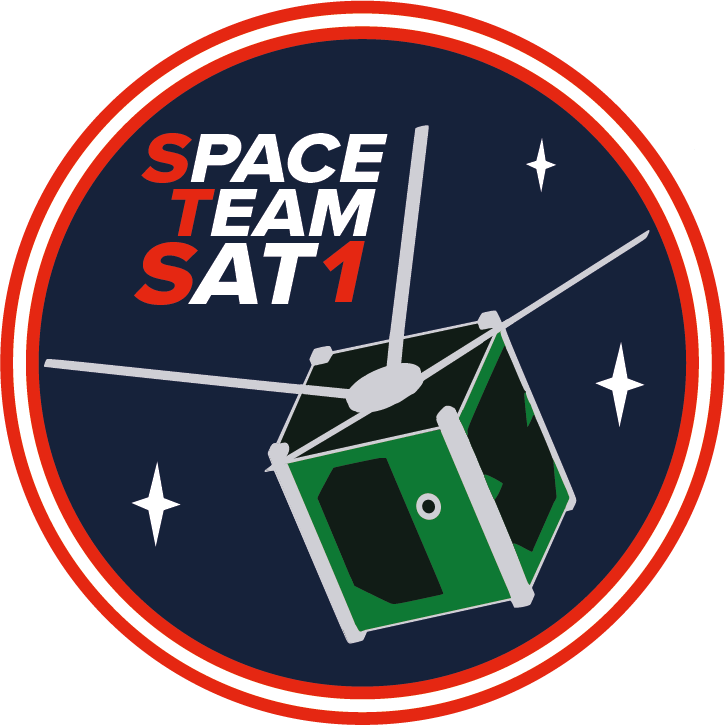
Sie wollen Mitmachen?
Ablauf
- Erstes Meeting mit Lehrkräften um das Projekt vorzustellen.
- Ausgabe von Entwicklungsmaterial an die Lehrkräfte (Tasks, Anleitung und geg. Entwicklungshardware).
- Die Tasks beruhen darauf, dass man verschiedene physikalische Messgrößen (Temperatur, Magnetfeld, etc.) im All misst, darstellt und interpretiert
- Zudem besteht die Möglichkeit Bilder und Videos zu machen
- Im Zuge der Lehrtätigkeiten und auch in der Freizeit entwickeln SchülerInnen Programme welche dann auf dem Satelliten laufen sollen.
- Die SchülerInnen können sich als Team zusammenschließen und gemeinsam an den Tasks arbeiten
- Updatemeetings mit dem TU Wien Space Team sind willkommen.
- Bei Fragen sind wir binnen 1-2 Tage erreichbar.
- Wenn das Programm der SchülerInnen fertig ist wird es an das TU Wien Space Team geschickt. Dort wird es final gecheckt und geprüft, ob es kein Sicherheitsrisiko darstellt.
- In gemeinsamer Rücksprache mit uns bezüglich der zeitlichen Ausführung des Programmes wird es auf dem, von uns entwickelten, Satelliten in den Erdorbit geschickt.
- Am Satelliten wird es dann zur gewünschten Zeit ausgeführt und die Ergebnisse werden dem TU Wien Space Team übermittelt.
- Das TU Wien Space Team schickt die Ergebnisse den SchülerInnen weiter.
Zeitrahmen
- Ab Mitte 2025 wollen wir Programme von SchülerInnen zum Satelliten schicken und ausführen
- Innerhalb eines Schuljahres kann man lernen mit der Hardware umzugehen und ein eigenes Programm für den Satelliten schreiben.
Ansprechperson
Projektleiter David Wagner:
david.wagner@spaceteam.at
Mögliche Fächer
- Schwerpunktfächer an HTL
- Diplomarbeit
- Informatik
- Physik
Benötigtes Vorwissen
- Die Grundsätze der Programmierung in einer beliebigen Programmiersprache sollten in der Schule vermittelt werden.
Altersstufe
- SchülerInnen sollten ca. 15 Jahre oder älter sein.
- Sollte gutes Programmierwissen vorhanden sein, können auch jüngere SchülerInnen mitmachen.
Kosten
- Ein Entwicklungsset kostet ca. ~ 55€ pro Team (a 2-4 SchülerInnen).
- Raspberry Pi 4 Model B ~ 45€
- Stromversorgung und Kabel ~ 10€
- Entwicklungsboard ~ 0€
… wird vom TU Wien Space Team gestellt (die Anzahl an Entwicklungsboards ist leider begrenzt und es werden aktuell nur maximal 2 Boards pro Schule ausgegeben, falls mehr benötigt werden können diese um ca. 25€ pro Stück nachgekauft werden)
Vermitteltes Wissen
- Vertiefung der Programmierkentnisse
- Kennenlernen von Weltraumtechnologien
- Kennenlernen von verschiedenen physikalischen Größen und deren Abhängigkeiten
- Darstellen und Interpretieren wissenschaftlicher Daten
SpaceTeamSat1 (STS1)
SpaceTeamSat1 (STS1) ist die aktuelle CubeSat Mission des TU Wien Space Teams, welche im August 2020 gestartet wurde. Ziel ist es, einen 1U CubeSat für Ausbildungszwecke zu entwickeln und im Orbit zu betreiben. Zudem soll eine eigene Groundstation zur Kommunikation mit dem CubeSat betrieben werden. Damit soll SchülerInnen in Österreich die Möglichkeit gegeben werden, selbst-entwickelte Software auf der Education Payload des Satelliten auszuführen. Die Payload des CubeSats “STS1” besteht aus einem Raspberry Pi, an dem diverse Sensoren und Kameras angeschlossen sind. SchülerInnen aus AHS und BHS können dann mittels Python auf diese zugreifen und Messungen sowie Bilder, aber auch Videos durchführen bzw. aufnehmen. Nach erfolgreicher Validierung des Codes am Boden, wird dieser per RF Kommunikation an den CubeSat“STS1” übertragen, welcher den Code ausführt und die Resultate der Experimente zurück an die Bodenstation übermittelt. Von dort werden die (aufbereiteten) Daten den SchülerInnen übergeben. Die Daten können dann im letzten Schritt ausgewertet, interpretiert und präsentiert werden. Ein wichtiger Aspekt dabei ist auch, dass die SchülerInnenteams den gesamten Prozess der Space Datenkommunikation kennenlernen. Dazu wird ein Mission Control Center beim TU Wien Space Team aufgebaut, das dann die aktuellen Statusdaten, Position des CubeSats, etc. darstellt. Da SatNOGS (https://satnogs.org/) die Basis für die Groundstation bildet und auch im Zuge der Mission den teilnehmenden Schulen nahegelegt wird, kann auch ein (reduziertes) Mission Control – ohne die Möglichkeit Daten an den CubeSat zu senden – an den Schulen aufgebaut werden. Dazu laufen bereits zwei Diplomarbeiten an einer HTL (Stand: Jänner 2024).
Da “STS1” dier erste CubeSat Mission des TU Wien Space Teams ist, welche selbstständig entwickelt wird, wird in der Ausarbeitung der Mission besonderen Wert auf den Aufbau von Know-how, was die Entwicklung, den Betrieb und die rechtlichen Schritte einer Satellitenmission betrifft, gelegt. Im Zuge dessen sind Reviews, wie sie bei größeren Space Missionen von ESA oder NASA auch üblich sind, bei uns auch an der Tagesordnung. Zum Einen erhöht das die Wahrscheinlichkeit für eine erfolgreiche Mission, um zum Anderen gewährleistet es die ordentliche Dokumentation der Mission, was dann auch zukünftige Generationen innerhalb des TU Wien Space Teams bei der Entwicklung von zukünftigen CubeSat Missionen zugutekommt.
Facts zur CubeSat Mission “SpaceTeamSat1”
- 1U CubeSat Plattform (10 x 10 x 12 cm³ und ca. 1,0 kg)
- STS1 wird auf einem Low Earth Orbit (LEO ~ 350 km – 500 km) betrieben
- STS1 wird ein Live-Labor für SchülerInnen der AHS und BHS sein
- STS1 wird die Amateurfunk Community ansprechen und das Thema “Amateurfunk” in die Klassenräume bringen. Zudem besteht für Schulen die Möglichkeit zum Betreiben einer eigenen SatNOGS Groundstation.
- STS1 wird durch den Launch Anbieter Isar Aerospace gelauncht
Education Mission Objectives
- SchülerInnenteams messen sich in einem Space Software Experiment Wettbewerb.
- Python Code wird auf der Education Payload auf Basis von Raspberry Pi ausgeführt.
- Unzählige Softwareprojekte sind möglich. Dafür stehen verschiedene Sensoren, sowie Kameras zur Verfügung.
- Die Messwerte und Bilder/Videos werden den SchülerInnenteams zur weiteren Bearbeitung zur Verfügung gestellt.
- Die SchülerInnenteams interpretieren und präsentieren ihre Resultate und lernen dadurch wichtige Aspekte der Weltraumtechnologien kennen.
Die Education Payload beinhaltet folgende Sensoren
- Temperatursensoren an verschiedenen Stellen im CubeSat
- Beschleunigungssensor (Accelerometer)
- Gyroskop
- Magnetfeldsensor
- UV Sensor
- Strom und Spannungswerte der Solarzellen und Akkus
- Dosimeter (Seibersdorf)
- 2 Kameras
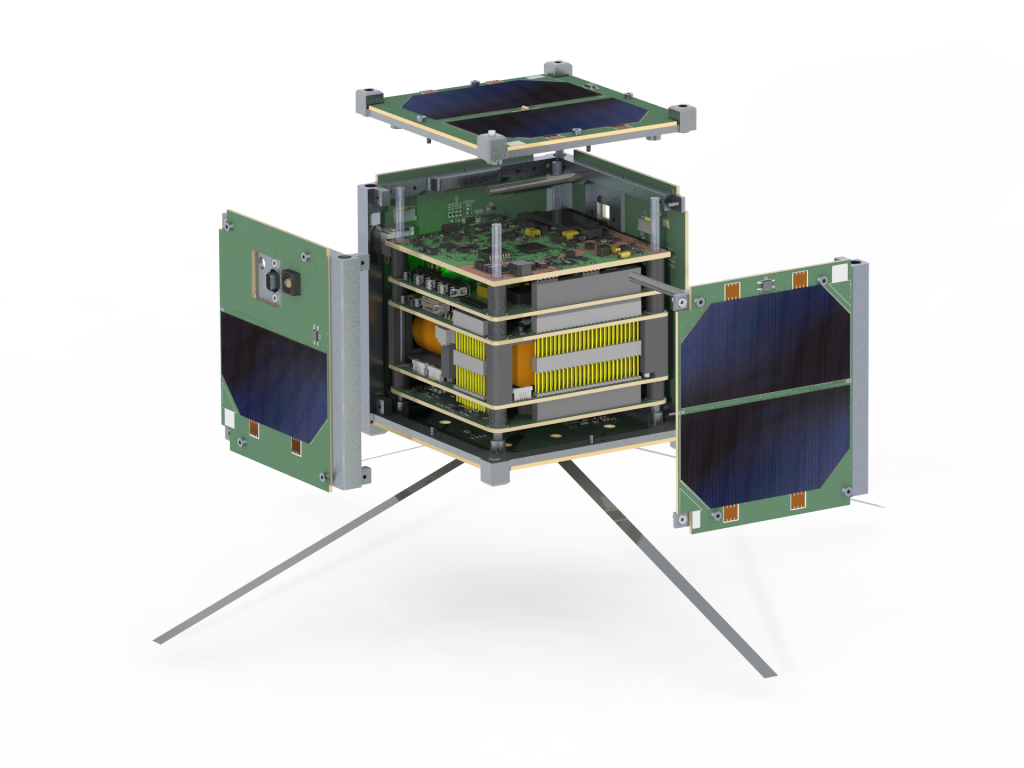
Im August 2020 fand der Kick Off-Workshop statt, in dem das Mission Statement und die Ziele der Mission definiert wurden.
mission statement
Begeisterung und Interesse für Technik und Wissenschaft sind wichtige Merkmale einer fortschrittlichen Gesellschaft. Sie folgen aus der Neugierde und dem Entdeckungswillen, welche tief in der menschlichen Natur verwurzelt sind. Heutzutage ermöglichen Weltraumtechnologien der Menschheit, diesem Drang nachzugehen und damit ihren geistigen Horizont weiter als jemals zuvor zu erweitern. Obwohl Weltraumtechnologien tief in der Popkultur verwurzelt sind und Organisationen wie die NASA, ESA oder SpaceX erfolgreich öffentlichkeitswirksame Missionen durchführen, scheint ein praktischer Zugang zu diesen Themen für die meisten Menschen unerreichbar. Daher wollen wir AHS und BHS SchülerInnen einen Einstieg in die Weltraumtechnologien ermöglichen, indem wir ihnen die Möglichkeit geben, eigene Software Experimente auf unserer selbst entwickelten CubeSat Plattform “Made in Austria” durchzuführen. Wir hoffen, dass dies ihren Bildungshorizont erweitert und wir dadurch die nächste Generation von Raumfahrt- und Wissenschaftsbegeisterten inspirieren können.
MISSIONSZIELE
Die Missionsziele dienen dazu, dass man sich dem Nutzen einer Weltraummission bewusst wird und definierte Ziele einer komplexen Space Mission hat.
PRIMÄRE MISSIONSZIELE
- Einen funktionierenden CubeSat zu entwickeln und zu fertigen.
- Den Betrieb unseres selbst entwickelten CubeSats zu gewährleisten.
- SchülerInnen die Möglichkeit geben, ihre selbst entwickelte Software auf einem CubeSat auszuführen.
- SchülerInnen zur Teilnahme an einem Weltraumprojekt zu motivieren.
SEKUNDÄRE MISSIONSZIELE
- Ein Bild aus dem Weltraum aufzunehmen.
- Die gesammelten Daten und Erfahrungen der Öffentlichkeit, und im speziellen anderen CubeSat Missionen, zugänglich zu machen.
EDUCATION MISSION
Während einige AHS und BHSkleine Satellitenprojekte, wie z.B. CanSat (https://ars.electronica.art/esero/de/projects/cansat/), AstroPi (https://astro-pi.org/) oder auch der Aufbau einer Bodenstation durchführen,, sind diese Projekte meist in Bodennähe und somit nicht realen Weltraumbedingungen ausgesetzt. Mit unserer CubeSat Mission wollen wir als TU Wien Space Team die Möglichkeiten erweitern und SchülerInnen mittels diversen Experimenten dazu animieren, an einer Space Mission teilzunehmen, die in einem tatsächlichen Orbit um die Erde stattfindet. Um dies zu ermöglichen, entwickeln wir eine 1U CubeSat Plattform, die Zugriffe auf einen Raspberry Pi und den daran angeschlossenen Sensoren und Kameras erlaubt. SchülerInnen können also eigene Software Experimente in Python schreiben und Daten von Sensoren im Weltall auswerten und auch interpretieren.
Wir wollen aber nicht nur Softwareprojekte umsetzen, sondern auch die Arbeit an an Hardware Themen fördern. Teilnehmende Schulen können vorgefertigte Raspberry Pi HATs mit den tatsächlichen Sensoren auf dem CubeSat beziehen, was die Entwicklung der Software Experimente auf der Erde ermöglicht. Teilnehmende HTLs können jedoch auch eigene Leiterplatten (PCBs) nach dem Vorbild unseres EDU Subsystems bestücken oder eigene Raspberry Pi HATs entwickeln. Da der CubeSat open-source sein wird, stehen alle Fertigungsunterlagen zur freien Verfügung. Zudem kann im Rahmen des Unterrichts eine eigene SatNOGS Bodenstation gebaut und betrieben werden, um selbst mit dem STS1 oder auch anderen Satelliten kommunizieren zu können. Da diese Groundstations auch außerhalb dieser CubeSat Mission betrieben werden können, können Schulen auch in Zukunft weiter Daten aus dem All empfangen.
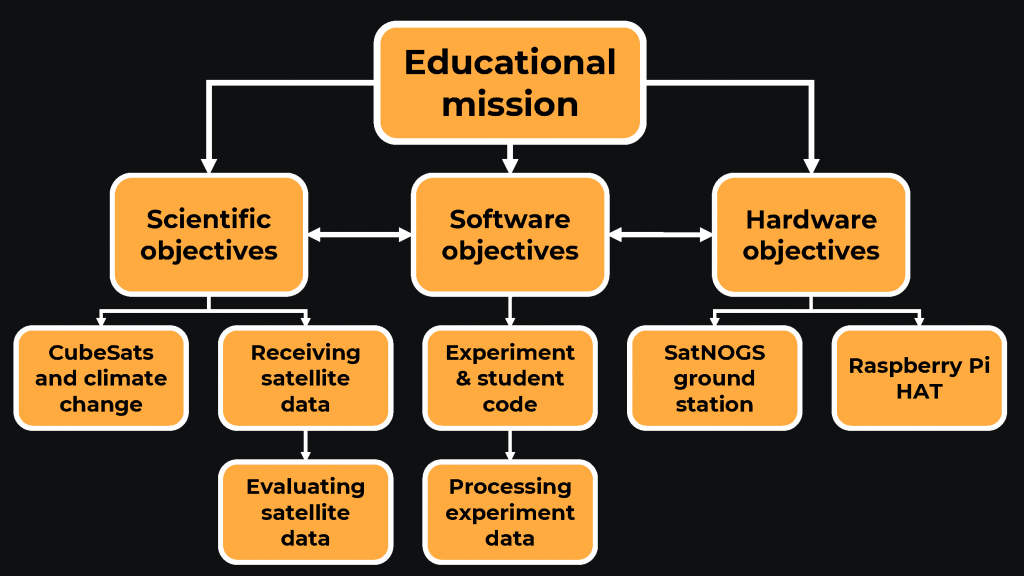
Da wir im Moment an der Detailausarbeitung der verschiedenen Aspekte beschäftigt sind, werden sich hier in Zukunft ausführlichere Beschreibungen finden.
Teilnehmende Schulen
Wenn Sie teilnehmen möchten (und SchülerIn oder eine Lehrkraft sind), wenden Sie sich bitte an david.wagner@spaceteam.at
- HTL Rankweil
- HTL Leonding
- tgm
- HTL Mödling
- HTL Hollabrunn
- Gymnasium Wasagasse
- Gymnasium Bruck a.d. Leitha
- HTL Salzburg
SYSTEM ARCHITEKTUR
Im Folgenden werden die einzelnen Subsysteme des CubeSats “STS1” vorgestellt. Dieser Teil wird regelmäßig aktualisiert und somit findet sich hier immer der aktuelle Stand der Entwicklungen (Stand: Jänner 2024).
Die drei wichtigsten Subsysteme von STS1 sind das Electrical Power System (EPS), das Communication Module und On-board Computer (COBC) sowie das Education Modul (EDU). Das EPS ist für die Stromerzeugung und -verteilung zuständig. Der COBC ist die Hauptverarbeitungs- und Scheduling Einheit des CubeSat und übernimmt auch die RF Kommunikation. Das EDU führt die Software Experimente aus, die von den einzelnen SchülerInnenteams bereitgestellt werden. Dazu ist dieses Modul mit einem Raspberry Pi und mehreren Sensoren, darunter zwei Kameras, ausgestattet.
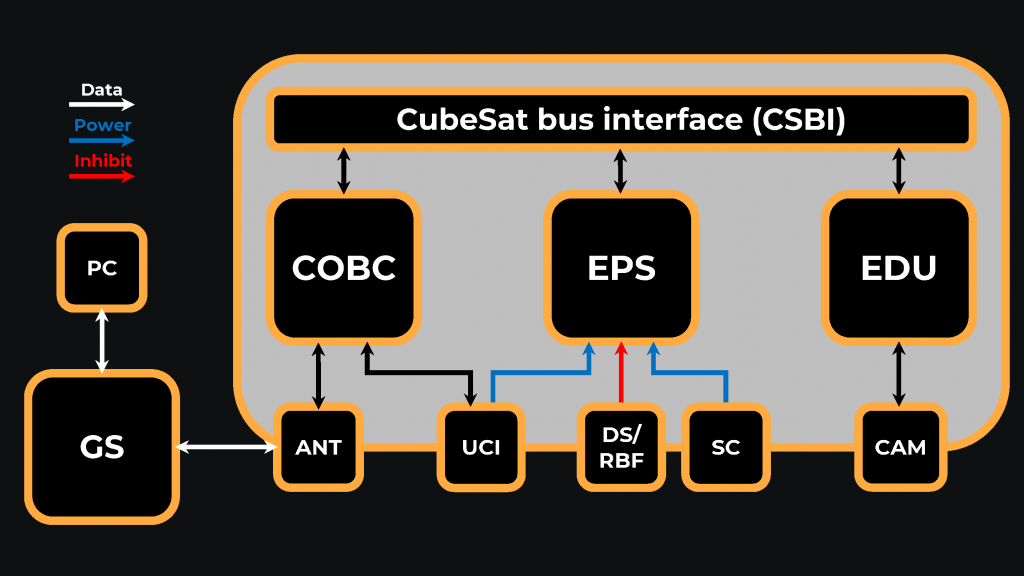
Die obige Abbildung zeigt die grundlegende Systemarchitektur des CubeSats und der zugehörigen Boden Infrastruktur. Das Antennensystem (ANT) dient der Kommunikation mit dem COBC, dass das RF Modul zum Empfangen und Senden von Daten enthält. Die Solarzellen (SC) sind direkt mit dem EPS verbunden und dienen der Gewinnung und zur Verfügung stellen von elektrischer Energie. Die SatNOGS Bodenstation (GS) dient zur Kommunikation (Senden von Kommandos an den CubeSat und Empfangen von Daten des CubeSats).. Das Umbilical Cord Interface (UCI) ermöglicht es uns, nach dem Zusammenbau des CubeSats den COBC neu zu programmieren und die Akkuszu laden. Die Deployment Switches (DS) und der Remove-Before-Flight-Pin (RBF) sorgen dafür, dass der CubeSat in der sicher gelagerten Konfiguration (im Chassis der Trägerrakete) nicht mit Strom versorgt wird. Innerhalb des EDU Subsystemskönnen die Kameras (CAM) Bildaufnahme Befehle empfangen. Bei diesem CubeSat wird ein passives Detumbling System verwendet, welches mittels zweier Hysteresis Rods in der X- und Y-Achse die Rotation verringert. Zusätzlich wird ein Permanentmagnet in der Z-Achse eingebaut, welcher diese Achse des Satelliten mit Hilfe des Erdmagnetfelds ausrichtet.
ELECTRICAL POWER SYSTEM – EPS
Das Electrical Power System (EPS) ist für die kontinuierliche Erzeugung und Bereitstellung von elektrischer Energie auf einem einzigen, ungeregelten Spannungslevel (Spannungsbus) verantwortlich. Die Energiegewinnung erfolgt ausschließlich über die Solarzellen, welche an den Außenflächen des CubeSats angebracht sind. Überschüssige Energie wird in Akkusgespeichert, um den Satelliten auch in Abschnitten des Orbits ohne Lichteinfall weiter mit Strom versorgen zu können. Das EPS enthält auch Sicherheitsfunktionen auf Systemebene, wie den Remove-Before-Flight-Pin (RBF), die Deployment Switches (DS) und einen Deployment Timer (DT). Alle diese Funktionen sollen eine vorzeitige Aktivierung des CubeSats verhindern, während er sich noch innerhalb der Trägerrakete befindet. Housekeeping Daten wie Akkuspannung, sowie Strom und Temperatur werden vom EPS gesammelt und dem COBC über eine Housekeeping Schnittstelle zur Verfügung gestellt. Zudem wird auf dem EPS der Release-Mechanismus der Antennen realisiert, welcher dazu dient, dass die Antennen des CubeSat ausklappen, sobald genügend elektrische Energie zur Verfügung steht.
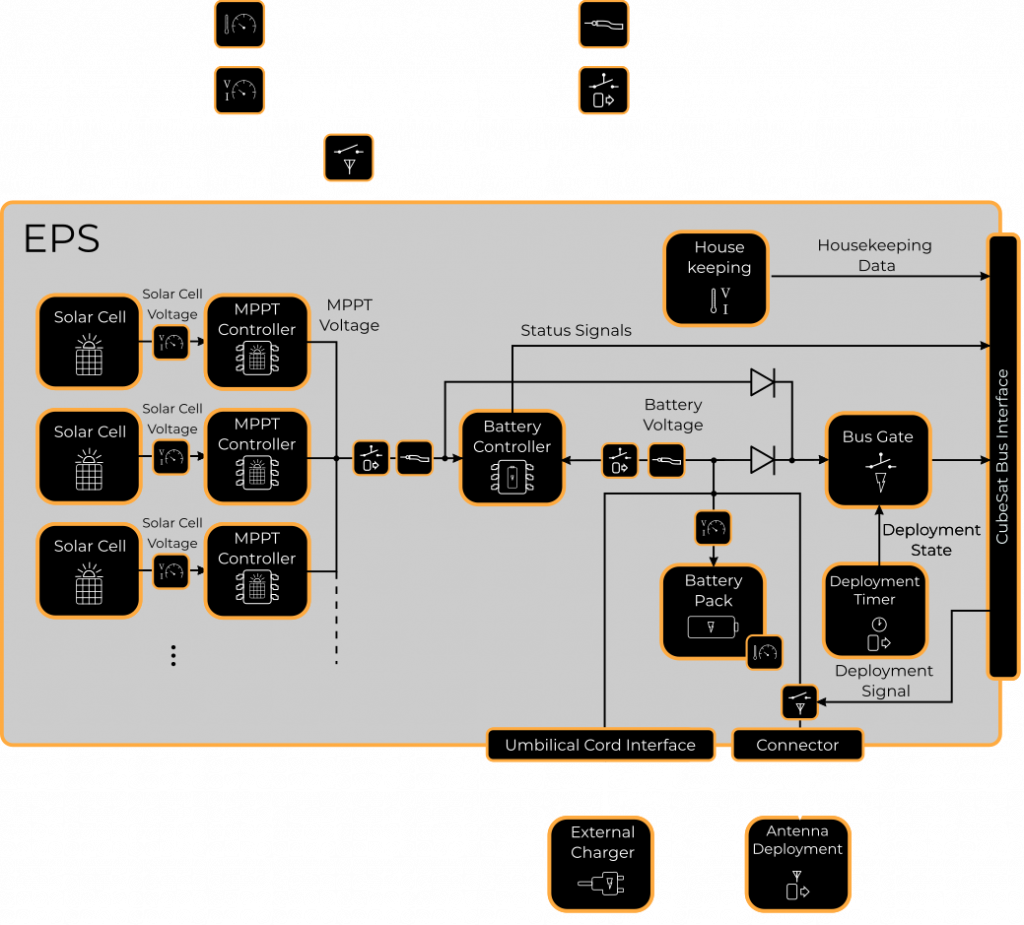
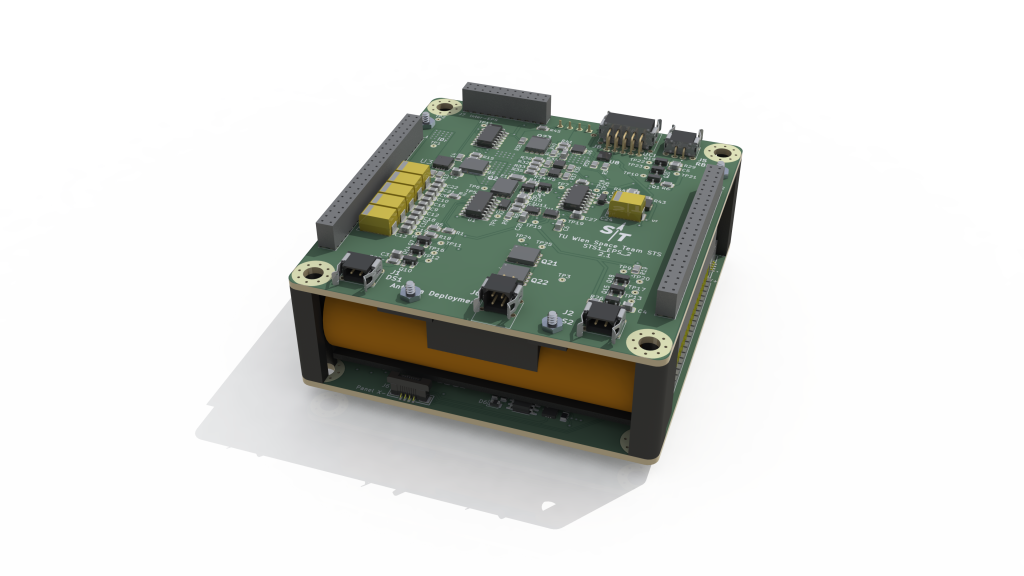
COMMUNICATION AND ON-BOARD COMPUTER – COBC
Der Communication and On-board Computer (COBC) des CubeSats STS1 vereint zwei klassische CubeSat Subsysteme:Das Kommunikationsmodul (COM) und den On-board Computer (OBC). Das COM ist für das Empfangen und Senden von Daten zuständig und der OBC plant und organisiert alle Aktivitäten des CubeSats. Dadurch fungiert der OBC als Master der CubeSat Plattform, indem er den Speicherzugriff verwaltet und auch die Education Unit (EDU) betreibt und verwaltet. Die Microcontroller Unit ist das Herzstück des (C)OBCs und steuert den gesamten Datenfluss sowie Kommandos an Bord des CubeSats. Wir verwenden hierfür einen STM32F411RE (kurz STM32), auf dem Rodos als Betriebssystem verwendet wird. Der STM32 in Kombination mit Rodos analysiert eingehende und ausgehende Daten, die von und zum Funkmodul geleitet werden. Außerdem verwaltet der STM32 alle Datenzugriffe – Lesen, Schreiben und Löschen – auf den externen Flash- und FRAM-Speicher und ist für den Datenaustausch mit der EDU zuständig. Der Flash hat begrenzte Schreibzyklen, jedoch eine relativgroße Speicherkapazität. Auf ihm ist deshalb ein speziell auf Flash-Speicher ausgelegtes Dateisystem zum Zwischenspeichern der SchülerInnenprogramme und deren Resultate aufgesetzt. Komplementär dazu ist der FRAM beliebig oft beschreibbar, jedoch bei geringerer Speicherkapazität. Er ist daher prädestiniert zum Ablegen kleinerer Datenmengen, die sich häufig ändern, wie z.B. der Housekeeping Daten, welche den aktuellen Zustand des CubeSats beinhalten. Das Funkmodul besteht aus einem SiLabs Chip, sowie einer Ausgangsstufe. Für die Kommunikation verwenden wir den Silabs Si4463 IC in Kombination mit einem LNA für eine hohe Empfängerempfindlichkeit und einem 2 W Leistungsverstärker für den Downlink. Wir verwenden (G)FSK mit Bitraten zwischen 2400 und 115200 Baud, wobei das tatsächliche Maximum von den realen Bedingungen abhängt.Der Protokollstack basiert auf dem CCSDS-Telemetrie/Telekommando Protokollstack mit einem robusten Kanalcodierungs- und Vorwärtsfehlerkorrekturschema.
Die gesamte Elektronik des COBCs wird durch einen Gleichspannungswandler versorgt, der die Spannung von der EPS zur Verfügung stellt. Diese Implementierung ist notwendig, da zwei verschiedene Spannungsbereiche (3.3 V und 5 V) für den Betrieb des COBC benötigt werden. Zudem muss gewährleistet sein, dass die Bauteile durch eine möglichst konstante Spannung versorgt werden.
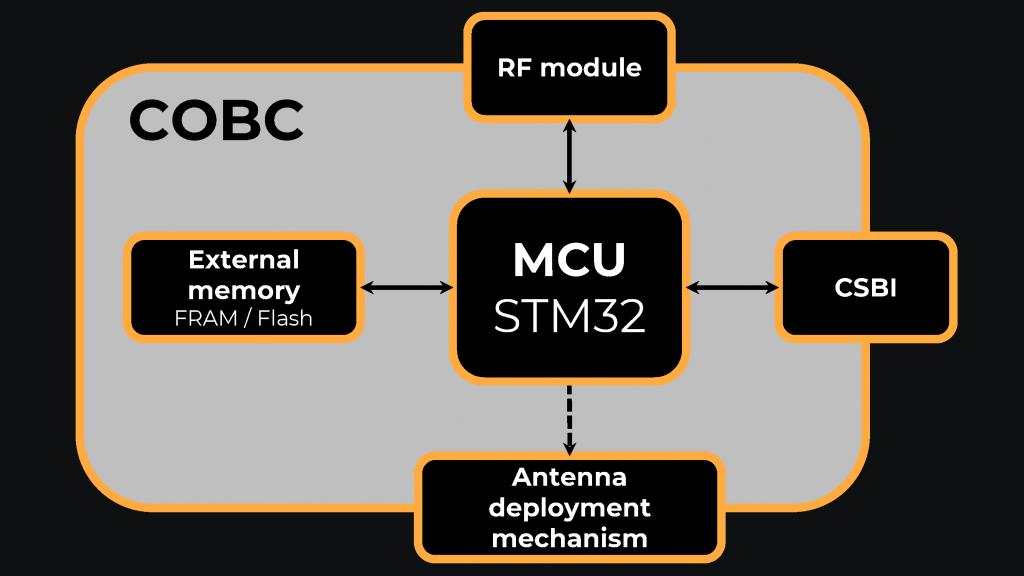
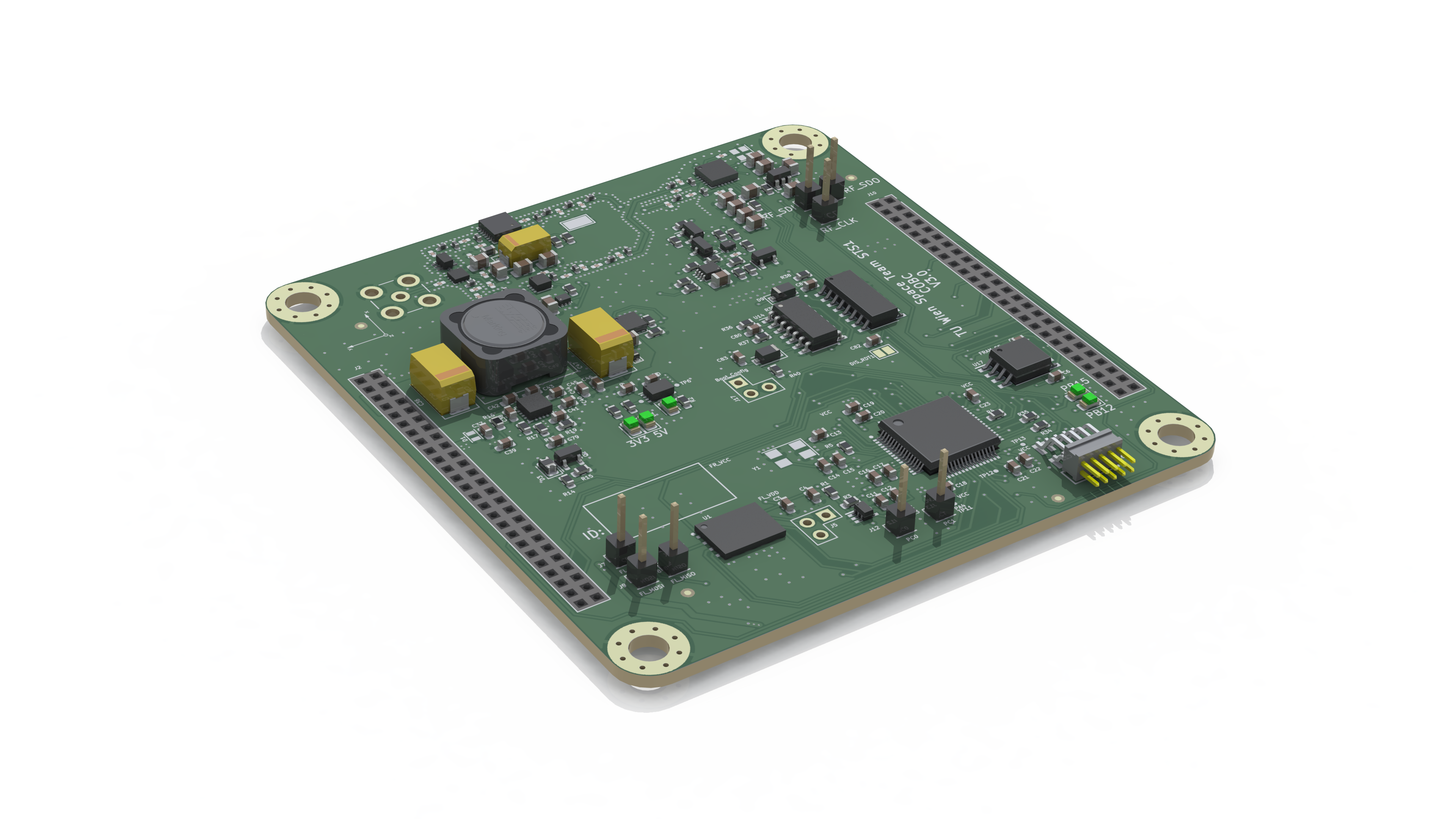
EDUCATION MODULE – EDU
Das Education Module (EDU) ist die Plattform, auf der SchülerInnen ihre Software Experimente durchführen werden. Es besteht aus einem Raspberry Pi, der Zugriff auf verschiedene Sensoren, darunter zwei Kameras, hat. Die erzeugten (und verarbeiteten) Daten können über einen Befehl heruntergeladen werden. Nach erfolgreichem Download werden die Daten verarbeitet und an die SchülerInnenteams zur Analyse übergeben.
Das EDU Modul verwendet die beliebte Raspberry Pi Plattform. Dies soll die Einstiegshürde sowohl für LehrerInnen als auch für SchülerInnen senken, da viele Ressourcen für die Plattform frei im Internet verfügbar sind und viele Jugendliche bereits mit der Plattform vertraut sind. Darüber hinaus werden wir versuchen, das Programmieren so zugänglich wie möglich zu halten, indem wir Software Bibliotheken für die gängigsten Operationen (z.B. Sensoren auslesen, Datenverarbeitung, etc.) auf dem EDU Modul bereitstellen. Um die Software Experimente auf dem Boden zu programmieren und zu testen, bieten wir die Möglichkeit an, EDU HATs für den Raspberry Pi zu beziehen oder auch selbst zu bestücken sowie zu entwickeln.
Folgende Sensoren werden auf dem EDU zu finden sein: Temperatursensoren, Magnetfeldsensor, Beschleunigungssensor, Gyroskop, GNSS Empfänger, Kameras, UV Sensoren und ein Dosimeter. Zudem besteht die Möglichkeit die Strom- und Spannungswerte der EPS – also der Solarzellen und Akkus – auszulesen. Mögliche Experimente mit diesen Sensoren sind z.B. die Bestimmung der Sonnenaktivität über mehrere Stunden oder auch das Erkennen von Wolken über dem Atlantik. Die SchülerInnen, die an der STS1 Bildungs Mission teilnehmen, werden praktische Erfahrungen beim Schreiben von tatsächlicher Weltraum-Software sammeln, was ihre Fähigkeiten zur Problemlösung und Teamarbeit fördern wird. Die gesamte Mission wird in Form eines Wettbewerbs abgehalten, bei dem wir uns die Unterstützung österreichischer Raumfahrtunternehmen und Weltraum Prominenz für die Ehrung der Siegerteams erhoffen. Weitere Details sind im Moment in der Ausarbeitung und werden hier laufend ergänzt.
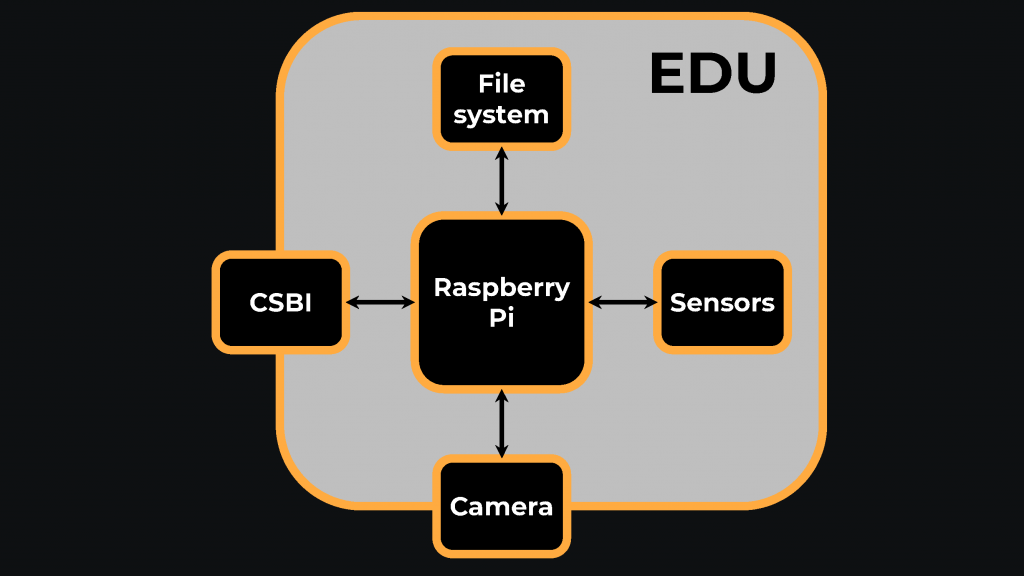
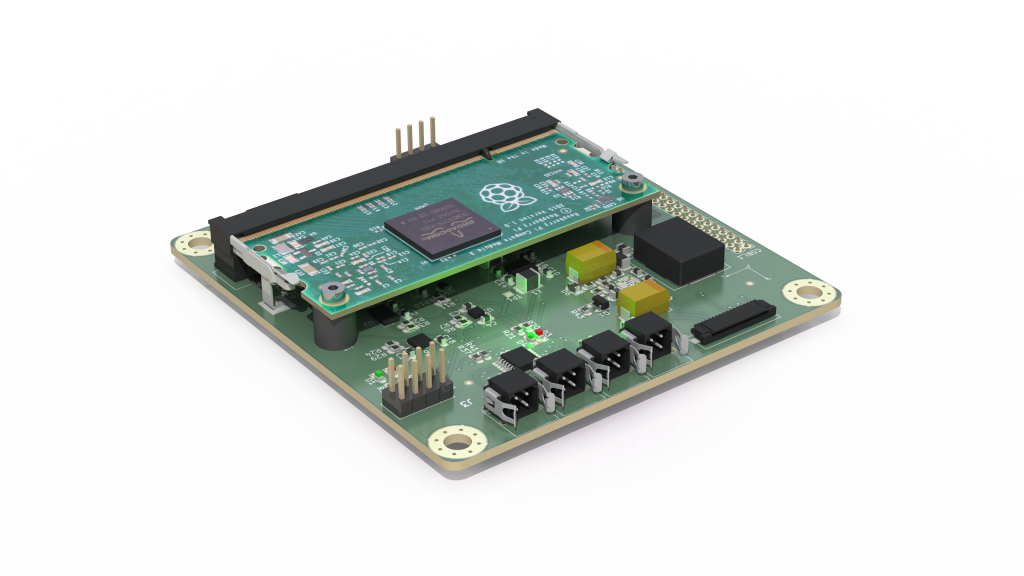
GROUND STATION UND SATNOGS
Unsere primäre Groundstation (GS) basiert auf dem rotierbaren GS Design des SatNOGS Projekts. Wir sind im Moment damit beschäftigt, das bestehende SatNOGS Empfänger Setup zu erweitern, damit auch eine bidirektionale Kommunikation mit unserem CubeSat möglich ist.
Das SatNOGS Projekt ermöglicht uns hier einerseits, auf einer durchdachten Softwarebasis aufzubauen und andererseits, unsere Downlink-Kapazität mit Hilfe des großen Netzwerks an Bodenstationen signifikant zu erweitern. SatNOGS erlaubt uns weiters, auch das Thema Space Kommunikation in unser Educationl Missionsziel einzubinden, da SchülerInnen ihre eigene Bodenstation bauen können, mit der sie Daten von unserem CubeSat und vielen anderen Objekten in einem Erdorbit (von anderen CubeSats bis hin zur ISS) empfangen können. Hierfür gibt es einfach aufzubauende Designs, um den SchülerInnen das Thema die später bis hin zu voll drehbaren Groundstations, mit gerichteten Antennen ausgebaut werden können.
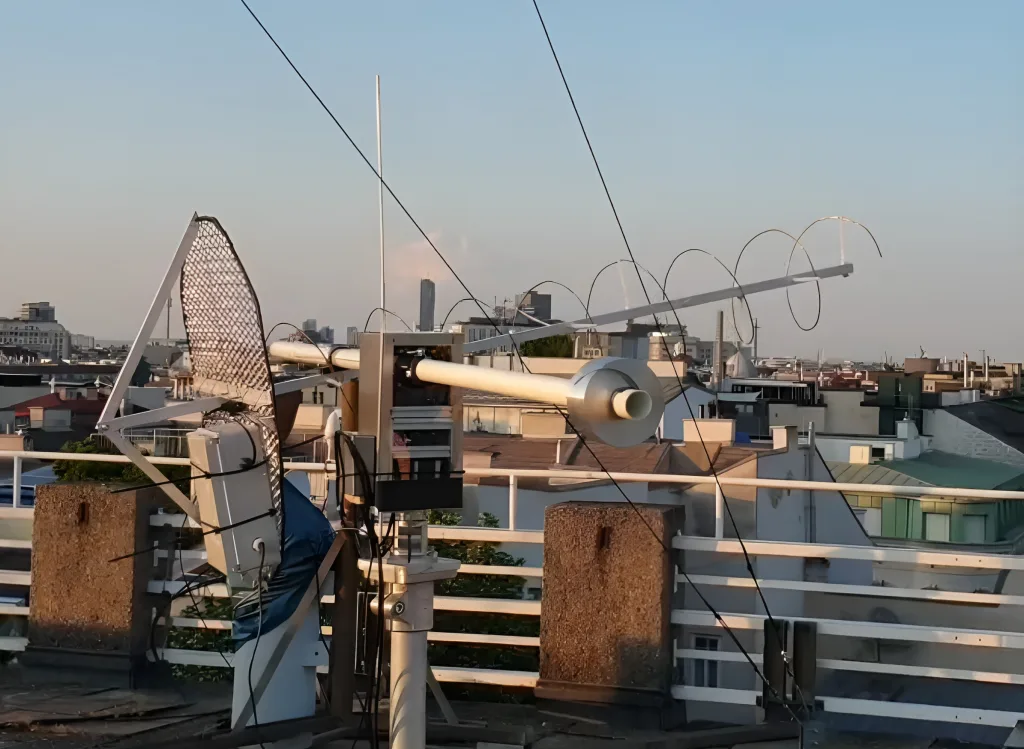
Mitglieder
- David Wagner – Project lead, System architecture
- David Freismuth – Technical project lead, EPS lead, System architecture
- Andriy Smolyanyuk – COBC hardware lead
- Florian Guggi – EDU software lead
- Patrick Kappl – System architecture, COBC software lead
- Raphael Behrle – Educational mission (Former: Project lead, System architecture)
- Gloria Reinbacher – School management
- Stefan Galavics – EDU hardware lead
- Simon Köfinger – EDU
- Stefan Lie-Ungurean – EPS, SidePanels lead
- Thomas Ranner – GS lead
- Tim Munhowen – Mechanics lead
- Daniel Schloms – COBC software
- Jakob Riepler – COBC, RF communication
- Jerome Hue – COBC software
- Elena Jochum – COBC software
- Florian Donauer – COBC software
- Kamil Chmela – COBC software
- Luka Menzel – COBC software
- Markus Roth – COBC software
- Mihai Bojor – COBC software
- Tomoya Hagen – COBC software
- Florian Rohrer – EDU software
- Leon Janisch – EPS
- Lili Weinmann-Eiching – EPS
- Nils Mosser – GSE
- Philipp Uhl – GSE
- Richard Dumser – GSE
- Gernot Kunz – GS database
- Nivin Thottathi – GS software
- Alan Antoine F4LAU – RF communication
- Noel Atzwanger – Software
Ehemalige Mitglieder
- Alexander Hartl – EPS
- Benjamin Geislinger – Mechanics
- Billal Teiba – EDU software
- Christoph Müllner – Mechanics
- Chrysostomos Siegl – FlatSat, EPS
- Fabian Kresse – Software
- Gera Kozhakhmetova – PR, Social Media
- Karim Ali – Integration Support
- Jan Pac – EDU, Software
- Jithin Njondimackal – COBC software
- Marianne Röchling – COBC software
- Marina Ivankovic – EDU
- Paul Schmitt – PR, Software
- Peter Kremsner – COBC, RF communication
- Simon Klaus – COBC
- Thomas Hirschbüchler – System architecture
- Zsófia Kálosi – GS Software